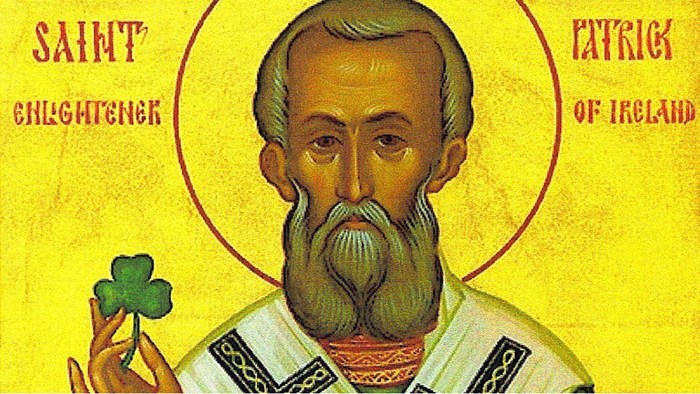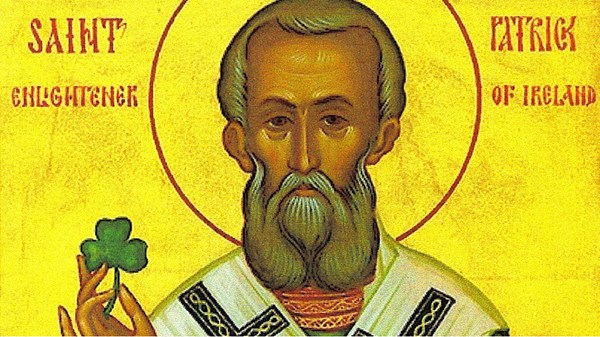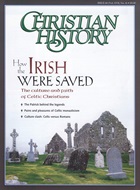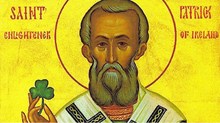
A fleet of 50 currachs (longboats) weaved its way toward the shore, where a young Roman Brit and his family walked. His name was Patricius, the 16-year-old son of a civil magistrate and tax collector. He had heard stories of Irish raiders who captured slaves and took them "to the ends of the world," and as he studied the longboats, he no doubt began imagining the worst.
With no Roman army to protect them (Roman legions had long since deserted Britain to protect Rome from barbarian invasions), Patricius and his town were unprepared for attack. The Irish warriors, wearing helmets and armed with spears, descended on the pebbled beach. The braying war horns struck terror into Patricius's heart, and he started to run toward town.
The warriors quickly demolished the village, and as Patricius darted among burning houses and screaming women, he was caught. The barbarians dragged him aboard a boat bound for the east coast of Ireland.
Patricius, better known as Saint Patrick, is remembered today as the saint who drove the snakes out of Ireland, the teacher who used the shamrock to explain the Trinity, and the namesake of annual parades in New York and Boston. What is less well-known is that Patrick was a humble missionary (this saint regularly referred to himself as "a sinner") of enormous courage. When he evangelized Ireland, he set in motion a series of events that impacted all of Europe. It all started when he was carried off into slavery around 430.
Escape from sin and slavery
Patrick was sold to a cruel warrior chief, whose opponents' heads sat atop sharp poles around his palisade in Northern Ireland. While Patrick minded his master's pigs in the nearby hills, he lived like an animal himself, enduring long bouts of hunger and thirst. Worst of all, he was isolated from other human beings for months at a time. Early missionaries to Britain had left a legacy of Christianity that young Patrick was exposed to and took with him into captivity. He had been a nominal Christian to this point; he now turned to the Christian God of his fathers for comfort.
"I would pray constantly during the daylight hours," he later recalled. "The love of God and the fear of him surrounded me more and more. And faith grew. And the spirit roused so that in one day I would say as many as a hundred prayers, and at night only slightly less."
After six years of slavery, Patrick received a supernatural message. "You do well to fast," a mysterious voice said to him. "Soon you will return to your homeland."
On The Mountain
Legend holds that Patrick rang a large bell (held in a reliquary, at the National Museum of Ireland) on the top of Eagle Mountain, now called Croagh Patrick. Depending on the legend, the bell scared away either Ireland's snakes or its demons. Patrick's other relic, a staff supposedly given to him by Jesus, was burned as an object of superstition in 1538.
Before long, the voice spoke again: "Come and see, your ship is waiting for you." So Patrick fled and ran 200 miles to a southeastern harbor. There he boarded a ship of traders, probably carrying Irish wolfhounds to the European continent.
After a three-day journey, the men landed in Gaul (modern France), where they found only devastation. Goths or Vandals had so decimated the land that no food was to be found in the once fertile area.
"What have you to say for yourself, Christian?" the ship's captain taunted. "You boast that your God is all powerful. We're starving to death, and we may not survive to see another soul."
Patrick answered confidently. "Nothing is impossible to God. Turn to him and he will send us food for our journey."
At that moment, a herd of pigs appeared, "seeming to block our path." Though Patrick instantly became "well regarded in their eyes," his companions offered their new-found food in sacrifice to their pagan gods.
Patrick did not partake.
The prodigious son returns
Many scholars believe Patrick then spent a period training for ministry in Lerins, an island off the south of France near Cannes. But his autobiographical Confession includes a huge gap after his escape from Ireland. When it picks up again "after a few years," he is back in Britain with his family.
It was there that Patrick received his call to evangelize Ireland—a vision like the apostle Paul's at Troas, when a Macedonian man pleaded, "Help us!"
"I had a vision in my dreams of a man who seemed to come from Ireland," Patrick wrote. "His name was Victoricius, and he carried countless letters, one of which he handed over to me. I read aloud where it began: 'The Voice of the Irish.' And as I began to read these words, I seemed to hear the voice of the same men who lived beside the forest of Foclut … and they cried out as with one voice, 'We appeal to you, holy servant boy, to come and walk among us.' I was deeply moved in heart and I could read no further, so I awoke."
Despite his reputation, Patrick wasn't really the first to bring Christianity to Ireland. Pope Celestine I sent a bishop named Palladius to the island in 431 (about the time Patrick was captured as a slave). Some scholars believe that Palladius and Patrick are one and the same individual, but most believe Palladius was unsuccessful (possibly martyred) and Patrick was sent in his place.
In any event, paganism was still dominant when Patrick arrived on the other side of the Irish Sea. "I dwell among gentiles," he wrote, "in the midst of pagan barbarians, worshipers of idols, and of unclean things."
Demons and druids
Patrick did not require the native Irish to surrender their belief in supernatural beings. They were only to regard these beings in a new light as demons. The fear of the old deities was transformed into hatred of demons. If Christianity had come to Ireland with only theological doctrines, the hope of immortal life, and ethical ideas—without miracles, mysteries, and rites—it could have never wooed the Celtic heart.
Predictably, Patrick faced the most opposition from the druids, who practiced magic, were skilled in secular learning (especially law and history) and advised Irish kings. Biographies of the saint are replete with stories of druids who "wished to kill holy Patrick."
Pilgrims
On the last Sunday of each July, between 25,000 and 30,000 pilgrims pass the saint's statue and climb to the top of Croagh Patrick, commemorating the saint's fasting there for 40 days and nights. Carbon dating of church ruins at the 2,710-foot summit has shown it dates from Patrick's day, supporting the legend that says Patrick climbed it.
"Daily I expect murder, fraud or captivity," Patrick wrote, "but I fear none of these things because of the promises of heaven. I have cast myself into the hands of God almighty who rules everywhere."
Indeed, Patrick almost delighted in taking risks for the gospel. "I must take this decision disregarding risks involved and make known the gifts of God and his everlasting consolation. Neither must we fear any such risk in faithfully preaching God's name boldly in every place, so that even after my death, a spiritual legacy may be left for my brethren and my children."
Still, Patrick periodically avoided such confrontations by paying protection money: "Patrick paid the price of 15 souls in gold and silver so that no evil persons should impede them as they traveled straight across the whole of Ireland," wrote one biographer.
Patrick was as fully convinced as the Celts that the power of the druids was real, but he brought news of a stronger power. The famous Lorica (or "Patrick's Breastplate"—see I Rise Today), a prayer of protection, may not have been written by Patrick (at least in its current form), but it expresses perfectly Patrick's confidence in God to protect him from "every fierce merciless force that may come upon my body and soul; against incantations of false prophets, against black laws of paganism, against false laws of heresy, against deceit of idolatry, against spells of women and smiths and druids."
According to legend, it worked. The King, Loiguire, set up a trap to kill Patrick, but as the bishop came near, all the king could see was a deer. (Thus the Breastplate has also been known as the Deer's Cry.)
There was probably a confrontation between Patrick and the druids, but scholars wonder if it was as dramatic and magical as later stories recounted. One biographer from the late 600s, Muirchœ, described Patrick challenging druids to contests at Tara, in which each party tried to outdo the other in working wonders before the audience:
"The custom was that whoever lit a fire before the king on that night of the year [Easter vigil] would be put to death. Patrick lit the paschal fire before the king on the hill of Slane. The people saw Patrick's fire throughout the plain, and the king ordered 27 chariots to go and seize Patrick . …
"Seeing that the impious heathen were about to attack him, Patrick rose and said clearly and loudly, 'May God come up to scatter his enemies, and may those who hate him flee from his face.' By this disaster, caused by Patrick's curse in the king's presence because of the king's order, seven times seven men fell. … And the king, driven by fear, came and bent his knees before the holy man . …
"[The next day], in a display of magic, a druid invoked demons and brought about a dark fog over the land. Patrick said to the druid, 'Cause the fog to disperse.' But he was unable to do it. Patrick prayed and gave his blessing, and suddenly the fog cleared and the sun shone. … And through the prayers of Patrick the flames of fire consumed the druid.
"And the king was greatly enraged at Patrick because of the death of his druid. Patrick said to the king, 'If you do not believe now, you will die on the spot for the wrath of God descends on your head.'
"The king summoned his council and said, 'It is better for me to believe than to die.' And he believed as did many others that day."
Yet to Patrick, the greatest enemy was one he had been intimately familiar with—slavery. He was, in fact, the first Christian to speak out strongly against the practice. Scholars agree he is the genuine author of a letter excommunicating a British tyrant, Coroticus, who had carried off some of Patrick's converts into slavery.
"Ravenous wolves have gulped down the Lord's own flock which was flourishing in Ireland," he wrote, "and the whole church cries out and laments for its sons and daughters." He called Coroticus's deed "wicked, so horrible, so unutterable," and told him to repent and to free the converts.
It remains unknown if he was successful in freeing Coroticus's slaves, but within his lifetime (or shortly thereafter), Patrick ended the entire Irish slave trade.
Royal missionary
Patrick concentrated the bulk of his missionary efforts on the country's one hundred or so tribal kings. If the king became a Christian, he reasoned, the people would too. This strategy was a success.
As kings converted, they gave their sons to Patrick in an old Irish custom for educating and "fostering" (Patrick, for his part, held up his end by distributing gifts to these kings). Eventually, the sons and daughters of the Irish were persuaded to become monks and nuns.
From kingdom to kingdom (Ireland did not yet have towns), Patrick worked much the same way. Once he converted a number of pagans, he built a church. One of his new disciples would be ordained as a deacon, priest, or bishop, and left in charge. If the chieftain had been gracious enough to grant a site for a monastery as well as a church, it was built too and functioned as a missionary station.
Before departing, Patrick gave the new converts (or their pastors) a compendium of Christian doctrine and the canons (rules).
Self doubt
Despite his success as a missionary, Patrick was self-conscious, especially about his educational background. "I still blush and fear more than anything to have my lack of learning brought out into the open," he wrote in his Confession. "For I am unable to explain my mind to learned people."
Nevertheless, he gives thanks to God, "who stirred up me, a fool, from the midst of those who are considered wise and learned in the practice of the law as well as persuasive in their speech and in every other way and ahead of these others, inspired me who is so despised by the world."
Over and over again, Patrick wrote that he was not worthy to be a bishop. He wasn't the only one with doubts. At one point, his ecclesiastical elders in Britain sent a deputation to investigate his mission. A number of concerns were brought up, including a rash moment of (unspecified) sin from his youth.
His Confession, in fact, was written in response to this investigation. Reeling from accusations, Patrick drew strength from God: "Indeed he bore me up, though I was trampled underfoot in such a way. For although I was put down and shamed, not too much harm came to me."
If Patrick was not confident about his own shortcomings, he held a deep sense of God's intimate involvement in his life. "I have known God as my authority, for he knows all things even before they are done," he wrote. "He would frequently forewarn me of many things by his divine response."
Indeed, Patrick recorded eight dreams he regarded as personal messages from God. And scattered throughout his Confession are tributes to God's goodness to him: "Tirelessly, I thank my God, who kept me faithful on the day I was tried, so that today I might offer to him, the Lord Jesus Christ, the sacrifice of my soul. He saved me in all dangers and perils . …So, whatever may come my way, good or bad, I equally tackle it, always giving thanks to God."
According to the Irish annals, Patrick died in 493, when he would have been in his seventies. But we do not know for sure when, where, or how he died. Monasteries at Armagh, Downpatrick, and Saul have all claimed his remains. His feast day is recorded as early as March 17, 797, with the annotation; "The flame of a splendid sun, the apostle of virginal Erin [Ireland], may Patrick with many thousands be the shelter of our wickedness."
Ultimate model
It is difficult to separate fact from fiction in the stories of Patrick's biographers. It is historically clear, however, that Patrick was one of the first great missionaries who brought the gospel beyond the boundaries of Roman civilization. According to tradition, he had established bishops throughout northern, central, and eastern Ireland. Only Munster, in the south, was to remain pagan until a century after Patrick's death.
Patrick was the ultimate model for Celtic Christians. He engaged in continuous prayer. He was enraptured by God and loved sacred Scripture. He also had a rich poetic imagination with the openness to hear God in dreams and visions and a love of nature and the created.
He is, then, most worthy of the appellation saint, as one "set apart" for a divine mission. As such, he became an inspiring example. Hundreds of Celtic monks, in emulation of Patrick, left their homeland to spread the gospel to Scotland, England, and continental Europe.
It is a legacy Patrick was proud of: "For God gave me such grace, that many people through me were reborn to God and afterward confirmed and brought to perfection. And so then a clergy was ordained for them everywhere."
Mary Cagney, a former editorial resident at Christianity Today, has written a screenplay titled A Celtic King.
© Copyright by the author or Christianity Today/Christian History magazine.
Click here for reprint information on Christian History.

Support Our Work
Subscribe to CT for less than $4.25/month






























